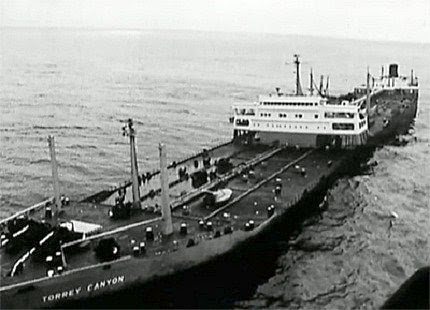The Torrey Canyon was a supertanker capable of carrying a cargo of 120,000 tons of crude oil, which was shipwrecked off the western coast of Cornwall, England in March 1967 causing an environmental disaster. At that time, the tanker was the largest vessel ever to be wrecked.
When laid down in the United States in 1959, it had a capacity of 60,000 tons but the ship was enlarged in Japan to 120,000 tons capacity. At the time of the accident it was registered in Liberia and owned by Barracuda Tanker Corporation, a subsidiary of Union Oil Company of California but chartered to British Petroleum. It was 974.4 feet (297.0 m) long, 125.4 feet (38.2 m) beam and 68.7 feet (20.9 m) draught.
The ship left the Kuwait National Petroleum Company refinery at Mina al-Ahmadi on its final voyage on 19 February 1967 with full cargo of crude oil, reaching the Canary Islands by 14 March. From there the planned route was to Milford Haven.
On 18 March 1967, owing to a navigational error, the Torrey Canyon struck Pollard's Rock on Seven Stones reef between the Cornish mainland and the Scilly Isles. An inquiry in Liberia, where the ship was registered, found Shipmaster Pastrengo Rugiati was to blame, because he took a shortcut to save time in getting to Milford Haven.
"Ashore on Seven Stones, require immediate assistance." This was the message which began the drama of the break up of the 118,000 dwt tanker the Torrey Canyon on Saturday 18th March 1967. Initially the report of the vessel running aground on the Seven Stones Rocks said that seven cargo tanks had been holed and that some 30,000 tons of crude oil had escaped. The inspection made on the second day of the drama showed that the damage was a lot more serious than first stated and that 14 of the 18 cargo tanks had been holed. A fleet of four tugs and equipement was at the site but the master did not agree to there salvageing the vessel at first and this caused considerable delay.
On the Sunday it was`realised that the rocks had ripped through the bottom plating beneath the forward and aft fuel tanks. At this stage the lifeboats and the Search and Rescue helicopters had lifted off most of the crew and only the Master and two other crew members remained on board.
The British Government and the salvage company tried to salvage the vessel in one piece and equipemnt was placed on board the Torrey Canyon to try to float the vessel and good progress was made through the Monday and Tuesday but then an explosion happened in the engine room and the salvage crews left the vessel and during this process the captain of one of the tugs was injured and died.
On the Wednesday the Royal Navy and the salvage company decided to try again and the vessel was partially floated by the Thursday . However the tanker was stuck firmly on the rocks and the weather started to deteriate. Force 7 to 8 winds were predicted for Friday 24th March so work was hectic to try and reflote the Torrey Canyon. On Saturday and Sunday further attempts were made despite the increasing deteriation of the weather. On the evening of Easter Sunday the vessel broke in two and the stern section started to settle in the water.
On Easter Monday, the fore ship, pounded by the enormous seas, broke in two. On the morning of Tuesday the Admiralty ordered everyone off the ship and away from the area and then Fifty three vessels sprayed 5000,000 gallons of detergent, itself toxic to wildlife, onto the slick which covered an area of 35 miles by 22 miles. With the wreck in three sections by this time, it still held about a third of its cargo, 40,000 tons. A decision was made that the RAF would bomb the wreck in order to attempt to set fire to the oil. The RAF dropped 200,000 lbs of explosive , 11,000 gallons of kerosene and 3,000 gallons of napalm onto the wreck The salvage attempt was officially abandoned.
In 1982 her entire forepart, still intact, was refloated and converted into an oil storage barge.
 The 120,000 tonne MV Torrey Canyon runs aground off the coast of Cornwall in March 1967
The 120,000 tonne MV Torrey Canyon runs aground off the coast of Cornwall in March 1967
 Navy Wessex respond to the incident
Navy Wessex respond to the incident
 A Navy Wessex winches personnel from the distressed vessel
A Navy Wessex winches personnel from the distressed vessel
 Navy Wessex contine to support the salvage/recovery operation
Navy Wessex contine to support the salvage/recovery operation
 At one point a BEA S61 gets involved
At one point a BEA S61 gets involved
 Not wanting to be left out the RAF too participate with this Wessex using a car park in Trevone Bay as a staging area (Photo: R.A. Cutlack)
Not wanting to be left out the RAF too participate with this Wessex using a car park in Trevone Bay as a staging area (Photo: R.A. Cutlack)
 A 'Dennis Oates' lorry unloads detergent for the clean-up operation in Cornwall
.
A 'Dennis Oates' lorry unloads detergent for the clean-up operation in Cornwall
.